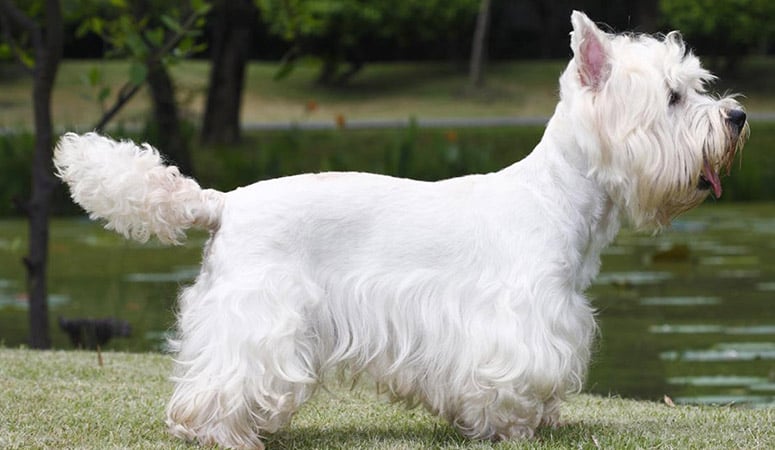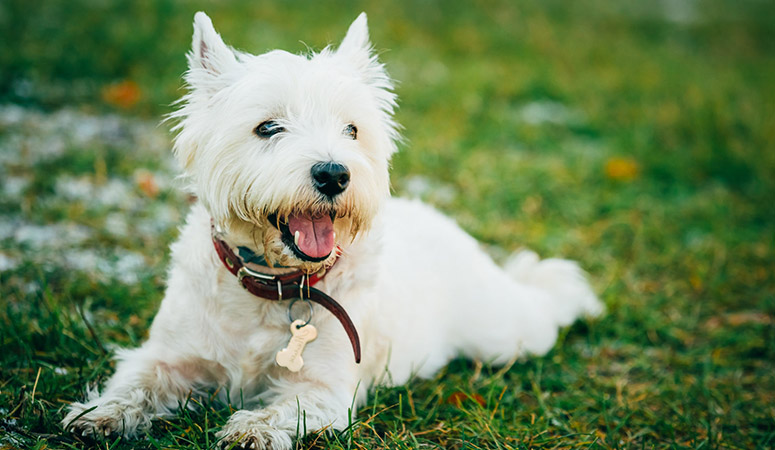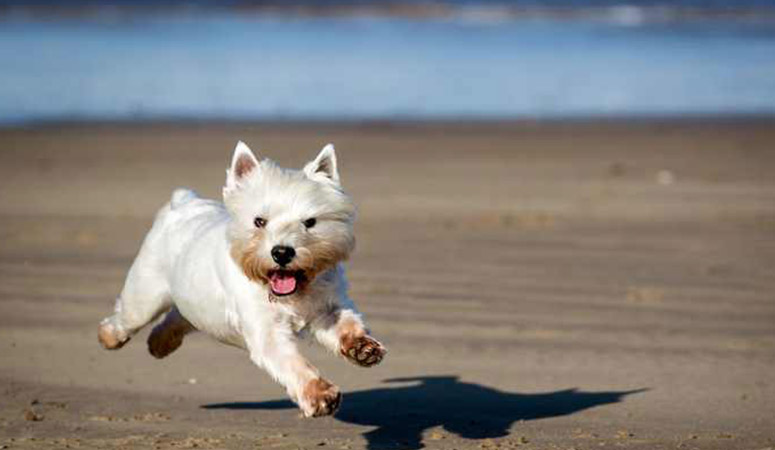West Highland White Terrier

Being active, alert, smart, confident, the West Highland White Terrier is adorable among the most popular of the small terriers. With strong and tough body, the dogs are bred to Bred to hunt rats and other underground rodents. With enough patience and time during their training, they will become faithful and intelligence.
| Other Names | Westie |
| Color | White |
| Height | Males: 10-12 inches. Females: 9-11 inches. |
| Weight | Males: 15-22 pounds. Females: 15-22 pounds. |
| Life Span | 13-15 years |
| Personality | Loyal, Happy, Entertaining |
| Exercise | Regular Exercise |
| Origin |
| Popularity | #44 |
| Groom Needs | Daily Brushing |
| Kids Friendly | Yes |
| Dog Friendly | Yes with supervision |
| Watch Dog | |
| Family Dog | |
| Litter Size | 3 to 5 |
West Highland White Terrier Pictures
West Highland White Terrier Video
Introduction
This little dog, the West Highland White Terrier which you don’t see around a lot, a rare jewel – smart and stubborn and very independent. He’s full of fun and is lively, needing a firm hand in training. He comes related from the Scottie and Cairns, weighing around 19 pounds and standing about 11 inches at the shoulders. They have short white hair and are nicknamed the “Westie”. Even though they are quite stocky, they are agile and fast. Their tough short hair allows them to shed dirt easily. They are generally easy dogs to keep and need plenty of exercise. Don’t leave your Westie to his own devices, because he can wreck your garden and bark a lot as well. They enjoy human company, but you need to socialize them to kids. The dogs were actually bred to have big barks so that hunters could hear them underground – their bark is a good alarm. Still, don’t expect them to be good guard dogs – they are way too friendly for that!
Living with West Highland White Terrier
With all-white coat and distinctive look, the Westies require careful grooming every four to six weeks to keep the Westie looking his best with the help of professional groomers. You should avoid over-bathing because Westies have a naturally dry coat.
Daily brushing and combing are necessary, and the coat just need shedding seasonally. The Westie will enjoy the grooming and bathing time.
Regular nail-trimming is necessary for his nails grow fast. To reduce tartar buildup, you should brush the dog’s teeth a couple of times a week.
Wipe his ears out with a cotton ball dampened with a gentle ear cleaner and check them once a week to prevent redness or odor that may lead to an infection.
The Westies don’t need lots of exercise like other breeds, but they still need jogs, hikes, play sessions or one or two daily walks. With the nature to chase anything that moves, the breed does best on a leash or in a fenced yard.
Being an indoor dog, he will make a good apartment dweller if the breeder gives the opportunities for regular walks and they can also be adaptable to city or country life.
Westies enjoy a great walk and like to play and romp. Besides, they excel in plenty of canine activities and sports, such as agility, rally and obedience with energy, intelligence and can-do attitude.
Also Westies enjoy playtime outdoors, such as fast-paced games, and they will become high-energy sizzlers at the dog park or in the backyard.
Swimming and retrieving are favored methods of exercise.
The Westies require high-quality dog food to keep fit and healthy, whether commercially manufactured or home-prepared with your veterinarian’s supervision and approval. Most Westies should be given a cup of high-qualit every day in two meals. But the amount of your god food depends on the age, size, activity level and metabolism. For example, a highly active dog will require more than a couch potato dog.
Treats may play an important part in training, but giving too many can lead to obesity. Watch your dog’s weight level and calorie consumption, or he will get overweight.
Clean, fresh water should be available at all times.
A responsible breeder should know which food are good for your dog and which are not. Consult your vet for help fine-tuning your Westie’s diet and weight.
Westies in general are healthy, but sometimes they will suffer from some health conditions just like other breeds. Some common health problems include craniomandibular osteopathy, legg-calve-perthes disease, cataracts, pulmonary fibrosis, pulmonary fibrosis and patellar luxation.
The breeder should screen their stock for health conditions regularly to help prevent some diseases. Hip, patella and ophthalmologist evaluation should be tested regularly.
Brush the dog’s teeth with toothpaste formulated for dogs to keep the gum and oral healthy.
Check with your vet, learn about these diseases and know what to do when they occur to ensure the dog a long, healthy life if you’re considering this breed.
Total Annual Cost: $2860.1
Cost is estimated for the first year and may vary depending on many factors, such as dog food, health care, leash, collar, licensing, possible fencing, crates, training and obedience classes, dog-walking, grooming, treats, toys, flea, tick, and heart-worm meds, microchips, etc.
With terrier traits, Westies will dig, bark, and go after vermin and they excel in tracking, flyball, agility, and obedience competitions. It’s a little difficult to change the habit of chasing vermin, but they are easy to be trained not to dig and only to bark once by proper training.
Bred to work alone with independence, adaptability, and intelligence, Westies is a bit hard to be trained, but the breeder will get good results if enough time and patience are paid to the dog. But you should keep in mind that Westies have great self-esteem and strong will that may increase training difficulties when the training gets harsh or bored.
As a social dog, he likes kids of every age, especially the older children at home and he gets along well with everyone. If you are busy with your work and have to leave him alone, you should provide toys, or turn on a radio, which can help keep him from feeling boring.
Crating training at a young age is a good way to ensure that your Westie doesn’t get into things he shouldn’t or have accidents at home. But it shouldn’t last too long.
History
It originates from the British Isles.
When King James I ruled in the early 1600s, this little dog was known as the dog of Argyleshire.
The breed was established later by Colonel Malcolm of Poltalloch in the 1800s –he used them for hunting. The legend goes that a reddish dog of his was mistakenly shot for a fox. Malcolm was devastated and decided there and then to only breed white dogs that could be easily identified in the field. His dogs were named after his estate.
The Westie was officially listed as the West Highland White Terrier in 1907 at the Crufts dog show in England. They chose the name because of the rugged character of the dogs as well as the area of their development.
George Campbell, the 8th Duke of Argyll was also trying to breed all-white terriers under the name Roseneath terrier, after his castle by that name. It was this breed that was accepted by the American Kennel Club in 1908 as the Roseneath Terrier. Later the name was changed to the West Highland white terrier a year later.
The Westies arrived in the United States in 1907 and the West Highland White Terrier Club of America was founded in 1909.
Helpful Information
Breed Club: WEST HIGHLAND WHITE TERRIER CLUB OF AMERICA
Breed Club Link: https://www.westieclubamerica.com/
Breed Club Rescue: National Westie Rescue
Breed Club Rescue Link: https://www.westieclubamerica.com/rescue/index.html




